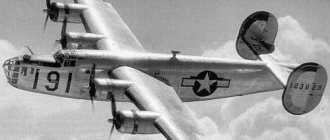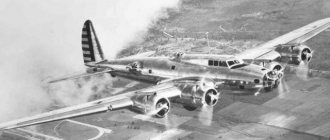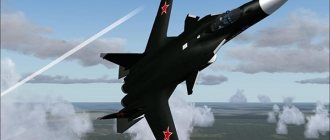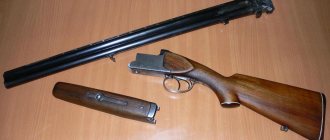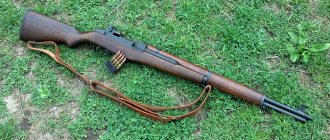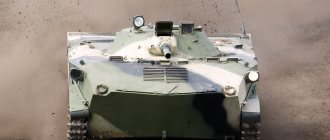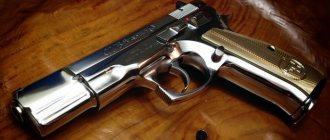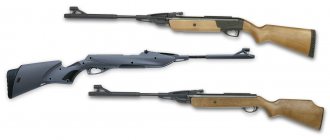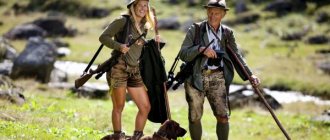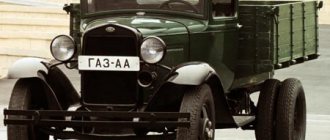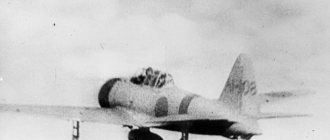Photo of the Consolidated PBY Catalina seaplane in flight
In 1932, the US Navy Bureau of Aeronautics issued requirements for a new patrol flying boat designed to significantly expand the fleet's long-range maritime reconnaissance capabilities. The aircraft was supposed to have a flight range of 4,800 km, a cruising speed of 160 km/h, and a maximum take-off weight of 11,350 kg. According to the requirements, the car had to be equipped with two Pratt & Whitney XR-1830-58 engines. became one of several who took part in the competition. The development of such a machine was headed by A. Ladden. Aerodynamically, it was a monoplane with a wing raised above the boat-like fuselage on a voluminous pylon (so wide that a flight mechanic’s workplace was organized in it) and supported by paired struts. Engines with pulling propellers were installed on the leading edge of the wing. The defensive armament included three machine gun mounts: a bow pivot mount and two in the side hatches behind the wing. Two underwing units provided suspension for bombs or torpedoes. The design of the “Model 28” was all-metal. The fuselage was made according to a semi-monocoque design with working skin. The underwing support floats were retractable (in the retracted position they formed wingtips). In general, so many new products were incorporated into the project that a patent was even issued for the design of the “Model 28”.
The calculated characteristics of the Model 28 exceeded the specifications in many respects, and in October 1933 the Navy ordered a prototype, designated XP3Y-1. Due to the need to master a number of new technological processes (primarily the production of large-sized stamped parts), the construction of the prototype was carried out rather slowly. XP3Y-1 first took to the air on March 21, 1935. Tests showed that the flight data of the new seaplane exceeded the most optimistic expectations: the flight range reached 6900 km, the maximum speed was 275 km/h, the service ceiling was 5760 m. The tail unit required some modifications and the bottom of the boat, but otherwise the car turned out great. The competitor, the Douglas XP3D-1, had similar flight characteristics, but cost $110,000, while the XP3Y-1 cost $90,000. The last factor became decisive in choosing the winner of the competition: at the end of June 1935, the Navy ordered the first production batch of 60 new flying boats. The classification changed from purely patrol (P) to patrol-bomber (PB). The prototype was modified into a series standard, designated XPBY-1. It was equipped with serial R-1830-64 engines, the bow pivot gun mount was replaced with a turret one, and a lower hatch machine gun mount was added. The converted vehicle resumed testing on May 21, 1936, showing even higher flight data - the maximum speed was 295 km/h.
Color photo of the PBY Catalina amphibious aircraft
In October 1936, deliveries of serial Catalinas began. Production continued until 1945, and in addition to the USA, they were also built in Canada and the USSR. produced 2,394 aircraft (2,159 at the plant in San Diego and 235 in New Orleans), the Naval Aircraft Factory in Philadelphia - 155, the Canadian branch of Boeing in Vancouver - 362, in Montreal - 369 and the Soviet plant No. 31 in Taganrog - 27. Thus, the total production volume was 3307 units (there are other, slightly different figures in publications).
Main modifications of Consolidated PBY Catalina flying boats
- Consolidated PBY -1 - 14-cylinder air-cooled Pratt & Whitney R-1830-64 engines (900 hp). Small arms - 4 7.62-mm Browning machine guns (1 in the bow turret, 2 in the side mounts and 1 in the lower hatch mount); on some copies, 12.7 mm machine guns were mounted in side mounts. Bomb load weight - 1814 kg (4,454 kg bomb); suspension of two torpedoes is possible. Crew - 7 people. From October 1936 to June 1937, 60 aircraft were manufactured.
- Consolidated PBY -2 - the design of the tail unit has been changed, some other improvements have been made. The power plant and weapons are similar to the PBY-1. From June 1937 to January 1938, 50 units were produced.
- Consolidated PBY -3 - an analogue of the PBY-2 with R-1830-66 engines (1000 hp) and a reinforced airframe. From January to August 1938, 66 copies were made.
- Consolidated PBY-4 - R-1830-72 engines (1050 hp). A pneumatic anti-icing system is installed. From May 1938 to June 1939, 33 aircraft were produced, including the XPBY-4 prototype (later converted to XPBY-5A).
- Consolidated PBY -5 - R-1830-82 (1200 hp) or (from May 1942) R-1830-92 engines of the same power. Small arms - 2 7.62 mm machine guns in the bow turret and lower hatch installation, 2 12.7 mm machine guns in side blisters; from the end of 1942, 2 7.62 mm machine guns were installed in the bow turret. Armor protection for the crew's workplaces has been installed. During production, friend-or-foe identification devices, magnetic anomaly detectors and radar were introduced into the onboard equipment of this and subsequent modifications, which significantly expanded the capabilities for detecting submarines. Crew -9-10 people. Produced from September 1940 to July 1943, 833 vehicles were manufactured.
- Consolidated PBY -5 A is an amphibious variant of the PBY-5 with a retractable tricycle landing gear. Protected fuel tanks were introduced. From October 1941 to January 1945, 743 aircraft were produced. 105 vehicles were transferred to the US Army Air Force under the designation OA-10. British designation: Catalina Mk.III and Mk.IV.
- Consolidated PBY -6 A - an analogue of the PBY-5A of later series with a PBN-1 type tail and a reinforced wing. From January to May 1945, 175 aircraft were produced. 74 units were transferred to the US Army Air Forces under the designation OA-10B.
- Consolidated PBN -1 "Nomad" - development of PBY-5 produced by Navel Aircraft Factory. The shape of the boat has been significantly changed, making the seaplane faster. The height of the vertical tail has been increased and the wing has been strengthened. A new retractable bow turret with 1 12.7 mm machine gun was used. Since February 1943, 155 aircraft have been produced.
- Consolidated РВ2В-1 - a licensed version of the PBY-5 produced by the Canadian branch, distinguished by the presence of a radar antenna radome above the cockpit. 240 aircraft were produced. British designation: Catalina Mk.IVB.
- Consolidated RV2V-2 - development of RV2V-1 with tail unit from PBN-1. Until March 1945, 67 aircraft were produced. British designation: Catalina Mk.VI.
- Consolidated PBV -1 is a variant of the PBY-5A produced by . 380 aircraft were produced, of which 150 were delivered to the Royal Canadian Air Force under the designation "Canso" A and 230 to the US Army Air Forces as OA-10A. In addition, 55 PBY-5A aircraft were produced by the Canadian branch.
- Consolidated "Catalina" Mk . I (“model 28-5ME”) - an analogue of PBY-5 for the UK. Engines - R-1830-S1C3-G (1200 hp). Small arms - 6 7.7 mm machine guns (1 each in the bow and lower mounts, 2 each in the side blisters). 99 aircraft were produced.
- Consolidated "Catalina" Mk . I B and Mk.IV - PBY-5A variants for Great Britain. 145 produced (75 Mk.I and 70 Mk.IV).
Royal Air Force Consolidated PBY Catalina.
- Consolidated "Catalina" Mk.II ("model 28-5MA") - an analogue of the PBY-5 for Australia. 25 released, incl. 18 for Australia and 7 for the UK.
- Consolidated "Catalina" Mk . IIA (“model 28-5MC”) is an analogue of the PBY-5, ordered for France, but after the defeat of the latter, the aircraft were transferred to Great Britain. 36 units were produced.
- "Model 28-5 MN " PBY -5 variant for the Dutch East Indies. 36 units produced.
- "Model 28-5 AMN " PBY -5 A variant for the Dutch East Indies. 12 units produced.
- "Model 28-5AMC" PBY -5 A variant for Canada. 14 units produced.
- GST is a version produced in the USSR. 9-cylinder M-62IR (1000 hp) or 14-cylinder M-87A (950 hp) or M-88 (1100 hp) engines were used. According to some data, M-87A are installed on 5 vehicles, according to others - only on two. M-88s are installed on 6 aircraft. Small arms - 4 7.62-mm ShKAS machine guns (one each in the bow, two side hatches and the lower hatch installation). Plant No. 31 in Taganrog in 1939-1940. produced 27 units. Some of the aircraft transferred to civil aviation received the designation MP-7 .
Literature
In Russian
Kotelnikov V.R. Aviation Lend-Lease. - M.: Russian Knights Foundation, 2015. - 368 p. — 1000 copies. — ISBN 985-5-9906036-3-9.
In English
- (English) Creed, Roscoe. PBY: The Catalina Flying Boat. Annapolis, MD: US Naval Institute Press, 1986. ISBN 0-87021-526-4.
- Crocker, Mel. Black Cats and Dumbos: WW II's Fighting PBYs. Crocker Media Expressions, 2002. ISBN 0-9712901-0-5.
- (English) Dorney, Louis B. US Navy PBY Catalina Units of the Pacific War. Botley, Oxford, UK: Osprey Publishing, 2007. ISBN 1-84176-911-8.
- (English) Hendrie, Andrew. Flying Cats: The Catalina Aircraft in World War II. Annapolis, MD: US Naval Institute Press, 1988. ISBN 0-87021-213-3.
- (English) Kinzey, Bert. PBY Catalina in Detail & Scale. Carrollton, TX: Squadron/Signal Publications, Inc., 2000. ISBN 1-888974-19-2.
- (English) Knott, Richard C. Black Cat Raiders of World War II. Annapolis, MD: US Naval Institute Press, 2000. ISBN 1-55750-471-7.
- (English) Legg, David. Consolidated PBY Catalina: The Peacetime Record. Annapolis, MD: US Naval Institute Press, 2002. ISBN 1-55750-245-5.
- (English) (English) Ragnarsson, Ragnar. US Navy PBY Catalina Units of the Atlantic War. Botley, Oxford, UK: Osprey Publishing, 2006. ISBN 1-84176-910-X.
- (English) Scarborough, William E. PBY Catalina in Action (Aircraft number 62). Carrollton, TX: Squadron/Signal Publications, Inc., 1983. ISBN 0-89747-149-0.
- (English) Scarborough, William E. PBY Catalina - Walk Around. Carrollton, TX: Squadron/Signal Publications, Inc., 1996. ISBN 0-89747-357-4.
- (English) Wagner, Ray. The Story of the PBY Catalina (Aero Biographies Volume 1). San Diego, CA: Flight Classics, 1972.
Flight performance characteristics of Consolidated Catalina flying boats
| Characteristic | PBY-1 | PBY-2 | PBY-3 | PBY-4 | PBY-5 | PBY-5A | PBY-6A | PBN-1 | GTS |
| Engines | Pratt & Whitney R-1830-64 | Pratt & Whitney R-1830-64 | Pratt & Whitney R-1830-66 | Pratt & Whitney R-1830-72 | Pratt & Whitney R-1830-92 | Pratt & Whitney R-1830-92 | Pratt & Whitney R-1830-92 | Pratt & Whitney R-1830-92 | M-62IR |
| power, hp | 900 | 900 | 1000 | 1050 | 1200 | 1200 | 1200 | 1200 | 1000 |
| Wingspan, m. | 31,7 | ||||||||
| Aircraft length, m. | 20,67 | 20,67 | 20,67 | 20,67 | 19,47 | 19,47 | 19,47 | 19,47 | 20,68 |
| Wing area, sq.m. | 130 | ||||||||
| Empty aircraft weight, kg. | 6460 | 6600 | 7500 | 7600 | 8460 | 9485 | 9735 | 8745 | 6670 |
| Take-off weight, kg. | 9860 | 12200 | 13800 | 15100 | 16065 | 15685 | 16525 | 12000 | |
| Maximum speed, km/h | 283 | 284 | 305 | 315 | 320 | 286 | 284 | 297 | 329 |
| Practical ceiling, m. | 6370 | 6430 | 7435 | 7345 | 6585 | 4480 | 4400 | 4600 | 5500 |
| Flight range, km. | 3385 | 3410 | 3480 | 3310 | 4560 | 4070 | 4055 | 4145 | 4500 |
Information sources
The model was checked against drawings from the War in the Air. The drawings do not claim to be super accurate, so all claims regarding geometry can be considered relative. Of the geometry flaws identified during the review, only the incorrect shape of the trailing edge of the wing fairing with the fuselage is confirmed by photographs.
Literature:
- War in the Air #118 “PBY Catalina”
- Pilot's Notes “Catalina I/IB/II/IV”
- Squadron Signal - In Action #62. “PBY Catalina”
- Osprey - Combat Aircraft #65 - US Navy PBY Catalina Units of the Atlantic War
- Squadron Signal - Walk Around #5 - PBY Catalina
- Bert Kinzey. "PBY Catalina" in detail & scale #8266
- Krzystov Janowicz. "Consolidated PBY Catalina CZ.1". Monografie Lotnitcze #82
Photo reviews:
- https://svsm.org/gallery/pby5a
- https://www.primeportal.net/hangar/hans-hermann_buhling/pby-5a_433915/index.php?Page=1
Combat use of Consolidated PBY Catalina aircraft
Front view of the Catalina flying boat
In the US Navy, the first production PBY-1s entered service with squadrons VP-11 and VP-6 in 1936. From January 1937, both squadrons were stationed at Pearl Harbor. Five squadrons received the PBY-2, five received the PBY-3. They were based primarily on the west coast of the United States, the Hawaiian Islands and the Panama Canal zone. After the outbreak of World War II, new air units began to be deployed on the Atlantic, serving as part of the “neutral patrol”. By August 1940, American Catalin squadrons were stationed in Newfoundland, Greenland and Iceland. They could only use weapons within a 200-mile zone from the US coast; in ocean areas, when German submarines were detected, a clear text message was transmitted to British ships and aircraft. American Catalinas also operated in the Caribbean Sea, based in Guantanamo Bay (Cuba) and Puerto Rico.
By the time of the Japanese attack on Pearl Harbor, 7 Catalin squadrons were stationed in Hawaii: VP-11 and VP-12 with PBY-1, VP-23 with PBY-2, VP-21 and VP-22 with PBY-3, and also VP-14 and VP-24 with PBY-5. On the morning of December 7, 1941, before the raid began, one of the VP-14 aircraft detected and attacked an unidentified submarine at the entrance to Pearl Harbor, but the report of this incident was ignored. As a result of the Japanese air raid, 27 Catalinas were destroyed and 6 more were damaged. It was also difficult for VP-101 and VP-102 stationed in the Philippines (in Cavite), which had 28 PBY-4. As a result of Japanese air raids and air battles, only 11 aircraft remained in service until December 13, 1941. A week later, 10 serviceable Catalinas were evacuated to Borneo. In January 1942, they were joined by the VP-22 squadron transferred from Hawaii.
These squadrons, combined into the 10th Patrol Wing, took part in the defense of the Dutch East Indies. When the remains of the wing were taken to Australia in March 1942, only 4 seaplanes remained. Two of them flew to the Philippines on April 27 to take General MacArthur's staff officers from the Corregidor Peninsula (Corregidor fell on May 6, 1942).
Subsequently, Catalinas were used in the Pacific Ocean, mainly as long-range sea reconnaissance aircraft. The most important role in the battles for Guadalcanal was played by the VP-11, VP-14 and VP-23 squadrons armed with these seaplanes. Their planes almost continuously patrolled the space between Truk (the main Japanese base) and Guadalcanal. They were also used for night torpedo and bomb attacks on Japanese ships. New units were constantly deployed - for example, in September 1942, the 17th naval wing was formed in the north of Australia. Three squadrons of his Catalins patrolled the waters from the Indian Ocean in the west to New Guinea in the east, covered convoys, and carried out search and rescue operations.
Since 1943, Catalinas have increasingly begun to be used for “armed reconnaissance”—patrol flights combined with strikes against detected naval targets. The crews of VP-33 achieved significant success in this; in September-October 1944, they sent enemy ships with a total tonnage of 100 thousand gross tons to the bottom in the Mindanao-Celebes-New Guinea region.
Catalina also carried out combat work in the North - since May 1942, the 4th Patrol Wing (squadrons VP-41 and VP-42, which were soon joined by VP-43, VP-62 and VP-42) fought in the Aleutian Islands 63), armed with PBY-5A amphibians.
After the United States entered the war, patrol seaplanes on the Atlantic began to operate more actively. The first victory took place on July 13, 1942, when the Catalina of VP-3 squadron sank submarine U153. After the Allied landings in North Africa in November 1942, VP-73 and VP-92 squadrons relocated to Morocco. They operated in the Mediterranean theater of operations until mid-1944.
In total, more than 20 American squadrons armed with Catalinas operated in the Atlantic. The most successful of these was VP-84, based in Iceland. November 1, 1942 the crew of Lieutenant R.S. Miller was damaged by submarine U664, and on November 5 the same crew destroyed U408. On December 10, another aircraft from this squadron sank U611. VP-84 was one of the first to successfully use Mk 24 “Fido” anti-submarine torpedoes with an acoustic homing system: on May 14, 1943, they sank U640, and on May 29, U200. On May 25, U467 was destroyed by conventional depth charges. On June 20, again with Fido torpedoes, they managed to send U388 to the bottom.
Along with naval aviation, Consolidated Catalina aircraft entered service with the US Army Air Force, where they were designated OA-10. Such amphibians were used in search and rescue squadrons. In particular, the 5th squadron was based in Great Britain, and the 1st squadron operated in the Mediterranean theater of operations. The 2nd Squadron operated in the Pacific Ocean. Since April 1945, the 6th Search and Rescue Squadron was stationed in Okinawa, and the 4th in the Mariana Islands.
The Royal Air Force received a total of 579 Consolidated Catalina and Canso seaplanes.
The first combat unit of the Coastal Command to master the new American vehicles was the 209th Squadron. It was her plane on the morning of May 26, 1941 that discovered the battleship Bismarck in the Atlantic, which was destroyed the next day. The success of this operation paved the way for the mass introduction of Catalins, and by the end of the year five squadrons were flying them: 202, 209, 210, 240 and 413 (Canadian).
The main task of the British Catalinas was to fight enemy submarines. The first success was achieved on August 25, 1941, when the crew of Flight Officer E.A. Juissa of 209 Squadron discovered U452 and attacked it with depth charges. The damaged submarine was finished off by a surface ship. And two days later, the same crew, together with other aircraft, took part in the hunt for U570, as a result of which the boat became a British trophy. On October 30, 1941, a Catalina from the same 209th squadron destroyed the U81 submarine.
Since April 1941, the 202nd Squadron, based in Gibraltar, flew combat missions on Catalinas. Its first success was the destruction (together with surface ships) of the Italian submarine Galileo Ferraris on October 30, 1941. In addition to anti-submarine patrols, seaplanes of this squadron were widely used
were involved in transporting urgent cargo and solving other problems. In June 1942, the 240th Squadron was transferred to the Mediterranean Sea. On June 7, aircraft of the 202nd squadron sank the submarine Veniero, and on the 9th, the Zaffiro became a victim of the 240th squadron. On February 14-15, 1943, a phenomenal flight lasting 22 hours and 20 minutes was performed by the crew of Flight Lieutenant G.R. Shirdon from the 202nd squadron. During it, the submarine U381 was seriously damaged, forced to interrupt the combat campaign, and 4 hours later the submarine U620 was sunk.
No. 209 Squadron operated from bases in South Africa from March 1942. In November 1942 it was joined by the 262nd Squadron, and early next year by the 259th and 265th. Their planes patrolled the adjacent waters of the Atlantic and Indian oceans. The first success in this area was achieved on August 20, 1943, when vehicles of the 259th and 265th squadrons sank U197 off Madagascar. On March 11, 1944, the submarine UIT22 became a victim of the 262nd Squadron.
By the time Japan entered the war, the 205th Squadron was stationed in the Far East. In the first weeks of the war, her Catalinas made reconnaissance flights, tried (without much success) to bomb Japanese airfields, and from January 1942 acted in the interests of besieged Singapore.
In July 1941, deliveries of Canso to the Royal Canadian Air Force began. The 116th Squadron was the first to receive them, and then 10 more squadrons based on both the Atlantic and Pacific coasts of the country, and from January 1944 the 162nd Squadron was stationed in Iceland. The Canso achieved its first success against German submarines on May 4, 1942, when aircraft of the 5th Squadron sank U209 and damaged U438. The most successful was the 162nd squadron, whose crews destroyed 5 German submarines before the end of the war. Several Canadian squadrons in the Royal Air Force also flew Catalinas. In particular, the 422nd squadron transported people and cargo to Murmansk in 1942. The 413th squadron was based on the island from the end of March 1942. Ceylon. It was her plane that on April 4 discovered a Japanese strike force approaching the island.
The Norwegians also fought in Catalinas as part of the Royal Air Force. In June-December 1942 they were operated by the 330th squadron, and from February 1943 by the 1477th flight, which was deployed to the 333rd squadron in May of the same year. In addition to anti-submarine patrols (the Norwegians sank U423 on June 17, 1944), the squadron was engaged in the transfer of reconnaissance and sabotage groups to the occupied territory and supplying resistance forces.
In February 1941, deliveries of Catalinas to Australia began. They were armed with the 11th and 20th squadrons of the Royal Australian Air Force. After the outbreak of the war in the Pacific, they were used not only for patrol and reconnaissance flights (some of them lasted 20-21 hours), but also for bombing strikes on the Japanese Truk base (not very successful), evacuating civilians from threatened areas and solving a number of other tasks. Since April 1942, the Catalinas carried out mine laying. In July, two more squadrons were armed with such seaplanes - the 40th (transport) and 42nd (reconnaissance and bomber). Until the end of the war, Australian Catalinas carried out active service and remained in service for several post-war years. In total, Australia received 151 Catalinas of various modifications.
In April 1943, deliveries of Catalinas (22 PBY-5s and 34 RV2B-1s) to the Royal New Zealand Air Force began. The first to receive them was the 6th Squadron, which was assigned search and rescue missions. The 490th Squadron, also armed with Catalinas, operated as part of the Royal Air Force in West Africa.
Maintenance of engines of the Consolidated PBY Catalina flying boat.
Before the Japanese attack, the Dutch East Indies Air Force managed to receive several Catalinas out of the 48 ordered. They armed two units. After the loss of the East Indies, the remnants of Dutch aviation were evacuated to Australia, and the Catalinas became part of the Royal Australian Air Force. In March 1942, the 321st (Dutch) squadron of the Royal Air Force, based at Pembroke Dock (UK), received Catalinas. At the beginning of January 1943, she arrived in Ceylon. In subsequent years, 321 Squadron patrolled the Indian Ocean and covered convoys, using bases in Durban (South Africa), on the island. Socotra, Maldives, etc. After the end of the war, the squadron was relocated to the Dutch East Indies. Subsequently, 321 Squadron flew transport and patrol missions in New Guinea. The last Catalinas from its composition were decommissioned in 1958.
Together with American squadrons in the Mediterranean theater of operations, the Free French squadrons VFP-1 and VFP-2 (according to the French nomenclature - 6FE and 8FE), formed, respectively, at the end of 1943 and in April 1944, carried out combat work on Catalinas. They were transferred under Lend-Lease to 30 PBY-5A amphibians. From mid-July 1944, flotilla 6FE was based on the island. Corsica, from where it took part in the landing in Southern France. In October 1944, she was redeployed to Morocco. The 8FE flotilla was already operating there, and in January 1945 it moved to West Africa. In the post-war period, Catalinas remained in service with French naval aviation until 1953.
In 1943, 7 PBY-5 aircraft were received by the Brazilian Air Force, and in 1944 they were joined by another 15 PBY-5A. The aircraft served in the 1st (Belem) and 2nd (Galeao) patrol groups. The biggest success of the Brazilian Catalinas was the destruction (together with other aircraft) of the submarine U199 on July 31, 1943. In the post-war years, the Catalinas were used by the Brazilian Air Force as transport aircraft in the Amazon. The latter flew until the mid-70s. In Latin America, Catalinas also served in Chile (3 PBY-5 and 7 OA-10A, the first of which entered service in June 1943), Argentina (18 Canso A, purchased since 1946), Colombia (13 PBY-5A, received post-war), Mexico (4 PBY-5A), Peru (8 PBY-5A and 4 OA-10A), Dominican Republic (6 PBY-5A and 2 OA-I0A), Cuba (2 OA-10).
Denmark bought 6 Canso A in 1946, and later an additional batch of PBY-6A. They were operated by Nos. 721 and 722 Squadrons, which operated primarily in Greenland. Sweden acquired three PBY-5As. These amphibians, locally designated Tr47, were used as search and rescue vehicles. Several examples of the PBY-5A served in Indonesia.
"Catalina" in the USSR
Licensed copy called GTS
(Gidro-Airplane Transport) was produced in Taganrog. From January 1939 to October 1941, 27 aircraft were produced, 11 of which were based in Sevastopol until the end of the defense of Crimea. According to unverified data, one GST in the staff of the 16th transport aviation detachment of the Northern Fleet survived until the end of the war.
Under Lend-Lease in 1944-45, 137 PBN-1 and 48 PBY-6A were delivered (possibly some PBY-5A - 20?), all of them were documented as KM-1. In the post-war period, domestic ASh-82s were installed on some Catalinas, due to the impossibility of purchasing native American engines; such aircraft were designated KM-2.
The arrival of American flying boats to active fleets began in the summer of 1944, initially to the Northern Fleet across the Atlantic, then to the Pacific through the Bering Strait. 59 vehicles were allocated for the Black Sea Fleet and polar aviation of the Main Northern Sea Route. The distillation was carried out through Brazil, Morocco, Iraq to Baku, and from there to Sevastopol. The last batch (28 vehicles) was transported to Moscow from June 23 to August 21, 1945.
The aircraft entered service with the 118th reconnaissance, 44th, 53rd and 54th mixed aviation regiments, as well as the 20th separate aviation squadron of the Northern Fleet, where they were used for aerial reconnaissance, search for submarines, and search engines. -rescue work. The most famous case was the rescue of the crew and passengers from the Marina Raskova transport sunk by a German submarine and the crews of the minesweepers T-114 and T-118 (a total of 73 people were rescued)
As part of the Baltic Fleet, Catalinas entered service with the 29th separate aviation squadron, where they were used. primarily as search and rescue missions.
In the Black Sea, Catalinas entered the 18th separate aviation squadron, specializing in anti-submarine defense tasks. The planes were not used to search for submarines, but were used for transport and also as search and rescue aircraft.
In total, by May 9, 1945, the air forces of the Western fleets numbered 107 PBN-1s, which amounted to 73% of their seaplane fleet. By the beginning of the war with Japan, the Pacific Fleet received 49 PBN-1 and 21 PBY-6A. The 16th reconnaissance air regiment was completely re-equipped with new equipment, and the 48th and 117th regiments completed their rearmament after the start of hostilities. Flying boats in the Far East solved the same problems as in Western theaters.
The Catalina flying boat, in terms of its flight characteristics and, especially, its on-board radio and instrumentation equipment, was the most modern seaplane in Soviet naval aviation.
Catalinas were used in the USSR Black Sea Fleet until 1955-56 as part of the 30th ODRAP at the Saki airfield. The pilots who flew them spoke very highly of the technology. Subsequently, the aircraft were written off and dismantled. [ source not specified 326 days
]
"Catalina" in the USSR
According to torpedo bomber sailors of the Northern Fleet, “Catalinas” (the number is unknown) during the Great Patriotic War served in the Northern Fleet aviation and were used, in particular, to select from the water the crews of Northern Fleet ships and aircraft sunk by the German fleet in the Barents Sea, for which purpose by plane a special hooking device was installed. Catalinas were also used for some time by the USSR Navy in the Pacific Ocean: during the landing of Soviet troops in Port Arthur (Lüshun) and Dalny (Dalian), 17 such aircraft splashed down in Port Arthur Bay. At least one aircraft, which was supplied under Lend-Lease, crashed in the Primorsky Territory in the summer of 1945: the aircraft belonged to a separate naval reconnaissance regiment of the Pacific Fleet, and it was found in May 2022.
The aircraft received excellent reviews from the sailors of the Pacific Fleet, although the Americans provided documentation in English without translation. The pilots and mechanics were able to independently understand the principles of control thanks to observations of the action of the aircraft units: the person in the pilot’s cockpit pressed the toggle switches, and the mechanic, having understood the purpose of the toggle switch, covered the inscription in English with a plaster and wrote on the plaster in Russian [ source not specified 957 days
].
Engines
The geometry of the engine hoods is normal, the hood flaps are made in a closed state, the walls of the carburetor air intake are a little thick. The photo shows a comparison of the model's hoods with the Quickboost resin hoods from the review article. But the oil cooler fairing has incorrect proportions and end shapes. In the model it is elongated and has straight ends with thick edges. The imitation of Pratt & Whitney R-1830-82 engines in the model is not bad for the 90s, but today it looks a little clumsy and rough. If desired, it can be upgraded with excellent resin engines from Vector and Aires. The profile of the propeller blades is far from the truth, but it is easy to modify. There are no special complaints about the pipes.
Kitography
The first Catalina models appeared in the late 60s. The first was the Revell PBY-5A Black Cat model, released in 1968. A little later, in 1971, Revell released the PBY-5 flying boat model. Then in the 80s there was a rare modification in a limited series - PBY-6A “Calypso II” by the famous oceanographer Zh.I. Cousteau with katran included. In the late 80's or early 90's the PBY-5A was repackaged by Matchbox. The model had external paneling and simple detailing. Around the same time - late 60s or early 70s - Airfix released its Catalina model, the PBY-5A. In many ways it was similar to the model from Revell and also had external paneling and simple detailing. For more than 20 years, these models remained unrivaled, until in 1993 Academy released a whole series of its Catalinas: the PBY-2, PBY-4, PBY-5 flying boats and the PBY-5A amphibian. When developing the model, Academy was largely guided by Airfix and Revell models. In terms of detailing, the model was not much farther from its ancient competitors, but it had internal jointing, riveting and good casting quality. Later in the 2000s, the Academy PBY-5A model was repackaged by St. Petersburg Modelist. Today, Academy models are the best and have no alternative in 72nd scale. You can read more about kitography and model reviews in the ScaleWiki Model Encyclopedia.
Casting and jointing
Casting is generally of high quality - standard for Academy. There is almost no flash (only on some small parts), there are a couple of sink marks - on the underwater part of the fuselage, a couple more between the blisters and on the windows. The jointing is generally normal, at the level of the 90s - moderately deep and not wide. Today it looks rough. But here is the riveting - large, deep with a large pitch. More like Thompson submachine gun bullet holes. It is advisable to remove it - putty and roll out a new one. There were an order of magnitude more rivets on the real plane. The deliberately rough imitation of canvas sagging on all control surfaces looks rude and implausible. Photo reviews confirm this. There is no huge amount of reinforcing pads.
Other aftermarket and conversions
Lanterns Falcon 1172 US NAVY WWII Part 2 – cockpit glazing and gunner blisters
Flashlights Squadron 9162 Consolidated PBY-5 Catalina Nose Turret/canopy/Side Blister
Paragon 72040 ASV MKII Radar Aerials (Sunderland, B-24, Catalina)
Metal Landing Gear Scale Aircraft Conversions 72037 PBY-5A Catalina Landing Gear - Low Quality Useless Product
- Conversion Renaissance Flight (ex FAB flight) 72004 PBY-5 Canso Catalina “Princesse des etoiles” Okavango conversion
- Conversion Renaissance Flight (ex FAB flight) 72011 PBY-5 Canso Catalina “Princesse des etoiles” Okavango conversion without Decals
- Conversion Red Roo 72117 PB2B-2 Catalina Conversion with decals
- Conversion Red Roo 72119 PB2B-2 Catalina Conversion
Conversion of RVHP Models 72130 Boeing PB2B-2/ Catalina MKVI
Conversion of RVHP Models 72131 Consolidated PBN-1 Nomad
Vacuum molded conversion BroPlan PBN-1 Nomad (PBY-5)
Vacuum molded conversion of BroPlan PBY-6A Nomad
Interesting Facts
- A member of the Tongan royal family, Baron Vaea, served as a pilot on this aircraft during World War II.
- On the Catalina patrol bomber, G. Hopkins (Roosevelt's personal representative for negotiations from July 29 to August 1, 1941 with the Soviet leader Stalin) made a heroic flight from Invergordon, Scotland to Murmansk and back to Scapa Flow. The flight took place at low altitude near the coast of Norway through territory controlled by the Luftwaffe. While approaching Scapa Flow, it was fired upon by an unidentified destroyer.
- The Catalina PBY-5A was used by the team of Jacques-Yves Cousteau. His son Philip, who was piloting the plane, crashed on this plane in 1979.
- On March 22, 1960, the family of American businessman Thomas Kendall landed a Catalina
in the Strait of Tiran, Saudi Arabia. They wanted to have dinner and then spend the night on the shores of the Red Sea. The next morning, they were attacked by local Bedouins. About 300 bullets hit the plane. Thomas Kendall and his secretary were injured. They tried to start the engines and take off, but after swimming 800 meters, the plane hit a coral reef and ran aground. The captured Americans were taken to Jeddah, where the ambassador spent several months seeking their release. Subsequently, when the formalities were settled, the Saudi authorities did not apologize and refused to pay compensation to the Kendalls. The PBY-5A Catalina seaplane still lies on the shores of the Red Sea.
